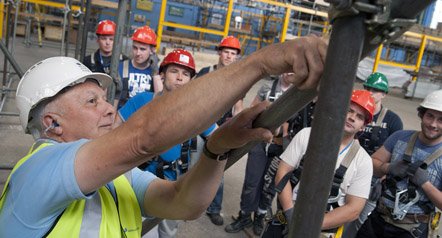In 2016, OSHA published a final rule to the Walking and Working Surfaces standard and added regulations for general industries. One of the major new regulations under this ruling is that general industries must focus on and provide employee safety training. The rule set specific training requirements such as:
- Being able to identify potential hazards and risks.
- Once these hazards are identified, an employee must understand how following the procedures that have been established will protect them from injury or death [29 CFR 1910.30(a)].
- The training must include how to properly use all safety equipment as well as what limitations the equipment might have. They must understand that if used incorrectly injury or death may occur [29 CFR 1910.30(a)(3)].
- Employees must remain well trained so retraining may be necessary from time to time. The new ruling does not specify a time requirement for retraining, but leaves it up to the employer to decide when it is necessary. For example, retraining should occur if new fall prevention equipment is implemented or if there are changes in safety procedures within the workplace [29 CFR 1910.30(c)].
Brei Richardson wrote a blog titled “Safety Training: Gaining Employee Buy-In” on the ASSE blog website EHS Works. She speaks specifically about how to successfully train adults and how getting your audience to “buy in” is extremely important. The learners must internalize the information and be able to see how they can use it every day. Brei also states that there are three major ways that adults learn: by listening, seeing, and by manipulating (auditory, visual, and tactile). Some adults may use more than one form of learning but most receive the most benefit by using one of the three. Reaching all types of learners may require training sessions to be more than just PowerPoint and presentations. Her three main objectives in training employees are as follows:
- Develop training that is practical and personal.
- Combine all three adult learning styles in order to reach everyone in your audience.
- Consistently use positive reinforcement in order to achieve the desired behaviors.
Utilizing these training suggestions may help meet the new OSHA requirement recently set by the Walking and Working Surfaces rule. SLIPNOT non slip products can help you meet other OSHA requirements by providing safe and durable flooring products. Contact us today for more information.
Richardson, Brei. “Safety Training: Gaining Employee Buy-In”. The American Society of Safety Engineers Blog. March 6, 2017. http://blog.asse.org/
OSHA training requirements information from: Hamel, Karen. “Fall Prevention Training for General Industry Employees.” Feb 3, 2017. March 6, 2017. http://ehstoday.com/fall-protection/fall-prevention-training-general-industry-employees?page=1




